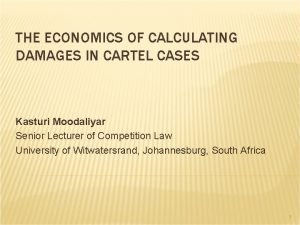Livelihoods and Employment Assessing Damages and Losses Impact


- Slides: 2

Livelihoods and Employment: Assessing Damages and Losses • Impact on personal income loss is approximately 110 -130 billion baht. Total employment in the affected provinces 16 million workers - - - � Formal employment: 15. 9% of formal enterprises and over 1 million workers (nearly 25% of the workforce in affected provinces) have been impacted. Over 68. 5 billion baht in total lost wages. Informal employment (work which does not provide social security or other social protections) : Nearly 34 - 37 billion baht loss from the flood. This impacted is accessed base on approximately 2. 1 – 2. 3 million informal worker affected by the flood. Based on the forecasted production loss, 129 billion baht lost as a consequence of 1. 08 million lost work-years (Work year = # of days worked in a year by a full-time worker). The two sectors with highest shares of work-year loss are wholesale/retail trade and hotel/ restaurant at 34. 7 and 38. 3 percent. The four sectors which are suffering from the highest personal income losses are wholesale/retail trade, hotel/restaurant, and financial intermediation, as well as transport/communication, which account for 33. 7, 29. 4, 19. 3 and 9. 5 percent, respectively. These substantial financial losses and recently exacerbated vulnerabilities require robust enterprise development and employment creation strategies to catalyze economic recovery.

Livelihoods and employment: Preliminary Recommendations Short-term Detailed labor market assessment once waters have receded, particularly regarding informal sector needs. Short-term local job creation (e. g. labour-intensive projects for debris clearance, rehabilitation of damaged facilities) benefits and protections extend to women workers, migrants, and other vulnerable populations. Medium-term Encourage skills training and enterprise development tailored to meet shifting labour demands and recovery needs Facilitate tripartite dialogue to engage the private sector as a partner in the recovery process and restore investor confidence. Long-term Ensure crisis prevention and pre-disaster planning policies catalyze local economic development.



